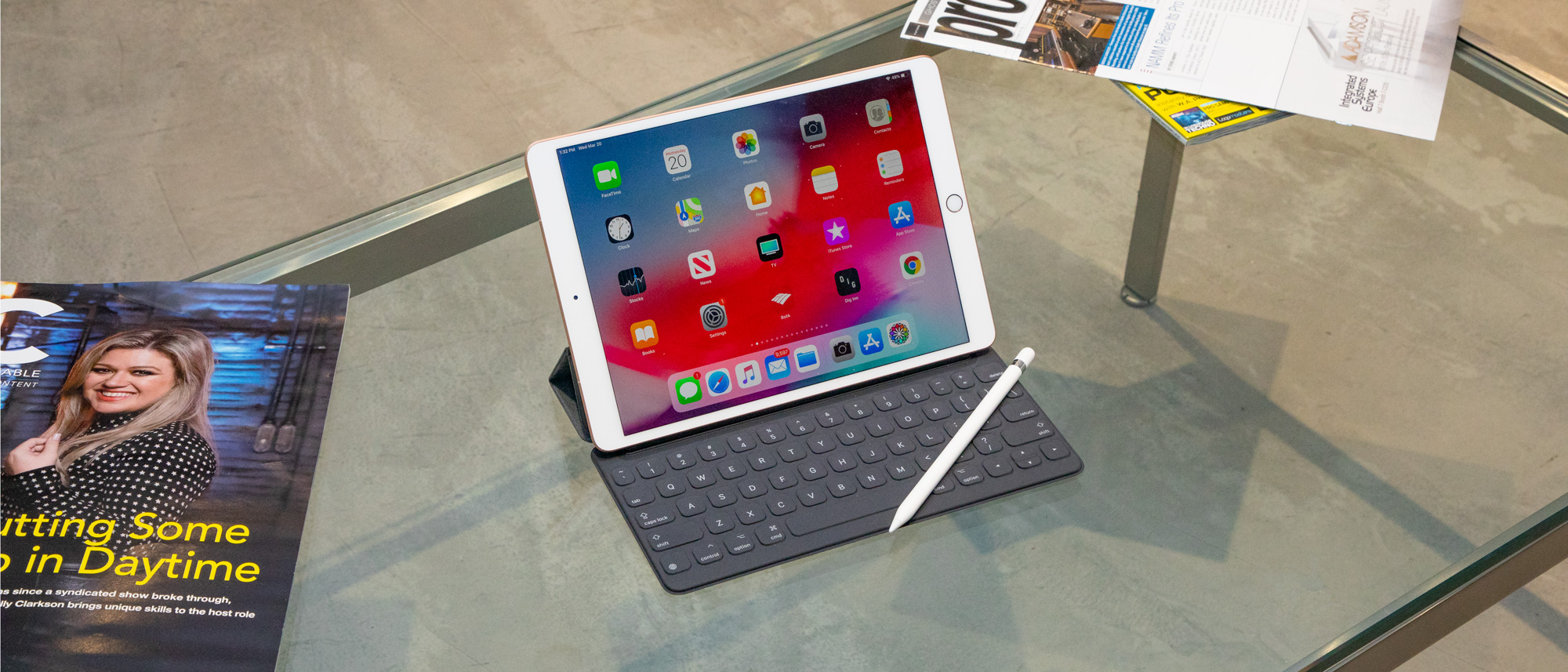TechRadar Verdict
The iPad Air 3 (2019) has serious horsepower hidden behind its laminated screen and uses Apple’s excellent Smart Keyboard for proper 2-in-1 for productivity. Its traditional design and first-gen Apple Pencil compatibility make it look dated, but it doubles the performance of the entry-level iPad 9.7. The ‘Air’ revival is a potential Back to School winner this year.
Pros
- +
Brilliant-looking laminated screen
- +
Cheapest Smart Keyboard iPad
- +
Fast charges via Lightning-to-USB-C
Cons
- -
Uses the 1st Gen Apple Pencil
- -
Traditional design doesn't wow
- -
Two speakers instead of four
Why you can trust TechRadar
2-minute review
The iPad Air is the awkward, destined-to-be-underrated middle child of Apple’s tablet lineup.
No, it’s not as cute as the baby, the 7.9-inch iPad mini, and its traditional looks make it a wallflower compared to the head-turning premium iPad Pro 11 and iPad Pro 12.9. It took us a few days of testing to realize why it’s still important in 2019.
That's doubly the case given the iPad Air 4, launched a year after the Air 3, is much more akin to an iPad Pro in design and specifications. Apple is clearly trying to steer the Air line away from its 'underrated middle child' status, and the iPad Air 3 is the last relic of the old ways.
You might find the iPad Air 3 - and other members of Apple's tablets line - discounted over Prime Day on June 21. During the event we'll report on all the good deals to help you save some cash.
Over time, we found the iPad Air 3 is the iPad for people who want 'a little more' than what the entry-level iPad 9.7 offers. It has a superior 10.5-inch display with thinner bezels, a faster chipset that matches the power in the iPhone XS, and a higher-resolution front-facing camera.
You have new options for an Air compared to its predecessor: it has larger storage configurations, compatibility with the excellent Apple Smart Keyboard cover, and performance numbers double those of the iPad 9.7. It’s a wholly better 2-in-1 productivity tool and a winner for Back to School shoppers.
We’re still left with wanting more. When we tested the device it ran iOS 12, which remains fairly limiting for Apple’s post-PC ‘computer’ pitch. The supports multitasking, sure, but too often we found a MacBook better for handling moderately complex workflows. It also only works with the first-gen Apple Pencil, not the magnetic second-gen Pencil, and that optional Smart Keyboard doesn’t light up like a MacBook keyboard. That makes it hard to type in the dark.
iPads have traditionally run on the same iOS as iPhones, but after we tested the iPad Apple released its own offshoot operating system, called iPadOS. We haven't tested iPadOS on this iPad, but we have used it on other tablets, where it works a treat.
This new operating system helps turn iPads from large iPhones into impressive mac-esque work stations, with functions like gesture controls and improved markups. Check out our iPadOS hub for everything you need to know about the new operating system.
More than anything, the iPad Air 3 (2019) is a repackaged version of the iPad Pro 2017 Apple has stopped selling. It's nearly identical in looks and solid 10-hour battery life. Only it has a serious internal specs bump and addresses our main reservation of the otherwise likable Pro: it finally has a palatable price.
You can look at it as the awkward middle child of Apple's iPad lineup, but it's also the cheapest iPad with real power and 2-in-1 functionality. Meaning, come Back to School season, it may have the last laugh.
Update: iPadOS 15, the newest version of Apple's iPad-focused software, is coming to the iPad Air 3 towards the end of 2021. It brings changes to multitasking, improved widgets that you can put in different places around the home screen, and improved note-taking with the Apple Pencil.
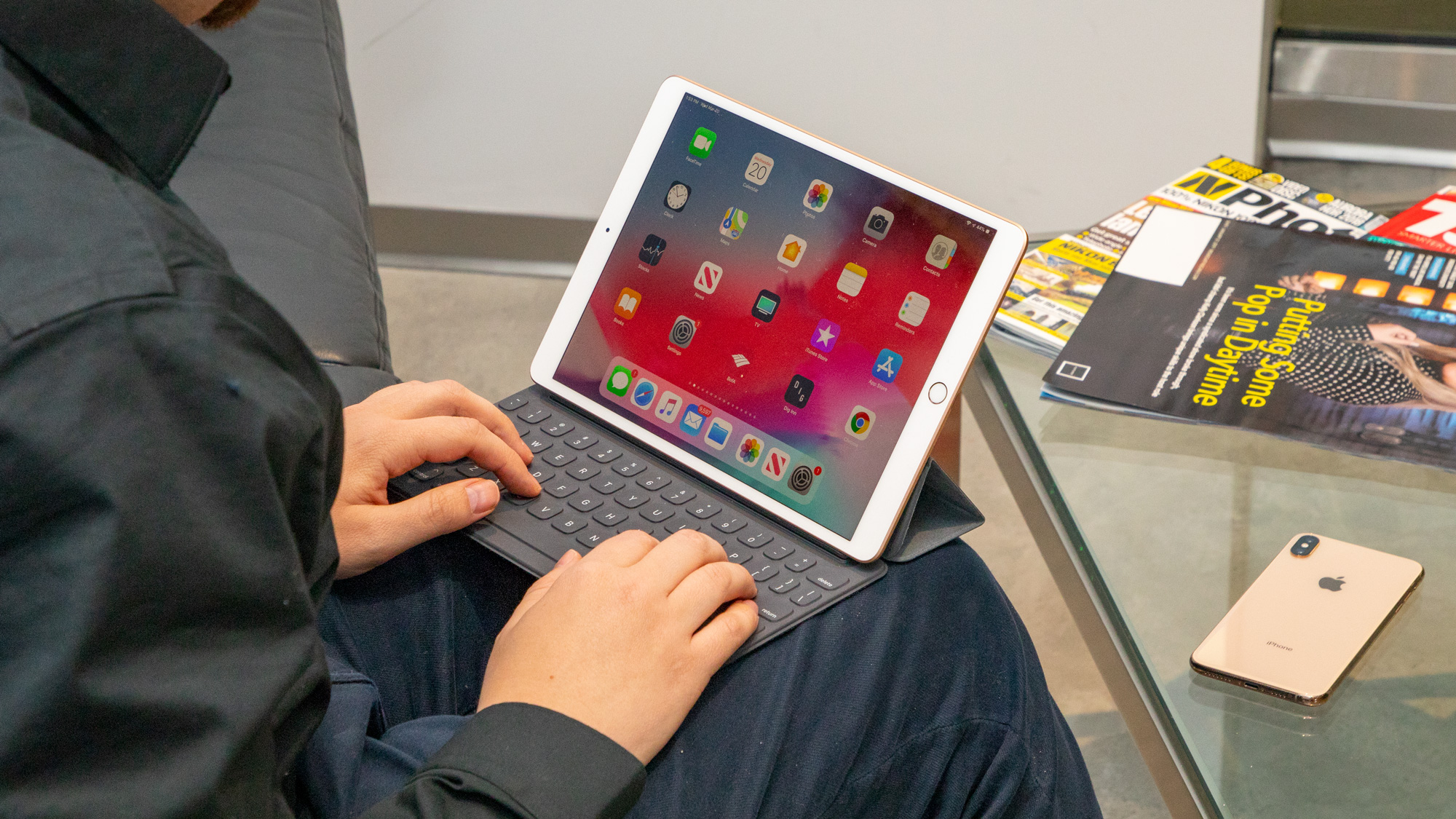
Price analysis
- This iPad Air (2019) costs $499 (£479, AU$779)
- iPad 9.7 is $329 (£319, AU$469)
- iPad Pro starts at $799 (£779, AU$1,129)
The iPad Air (2019) release date was Monday, March 25, following a subdued, very-out-of-character announcement via an Apple press release on Monday, March 18.
Its price is a complicated selling point. It costs less than the iPad Pro 10.5 (2017) at launch, but priced the same as this two-year-old Pro tablet if you consider current sales. Is there any difference between the two? Kind of. The Air has better internal specs and has eSIM support, but only two speakers compared to the old Pro’s four.
The iPad 9.7 (2018) is the real competition – still on sale everywhere. It costs $329 (£319, AU$469), and we saw it drop to $229 during Black Friday 2018. It was such a good deal, I bought two for my parents, though I find it to be more of a read, not write-focused tablet. The same applies to the new pint-sized iPad mini (2019), starting at $399 (£399, AU$599).
The iPad Pro 11 and 12.9, on the other end of the spectrum, start at $799 (£779, AU$1,129) for the 11-inch size. They’re the only Air alternative with reliable 2-in-1 productivity chops. The iPad Air (2019) ends up being your cheapest answer to Apple Smart Keyboard cover support.
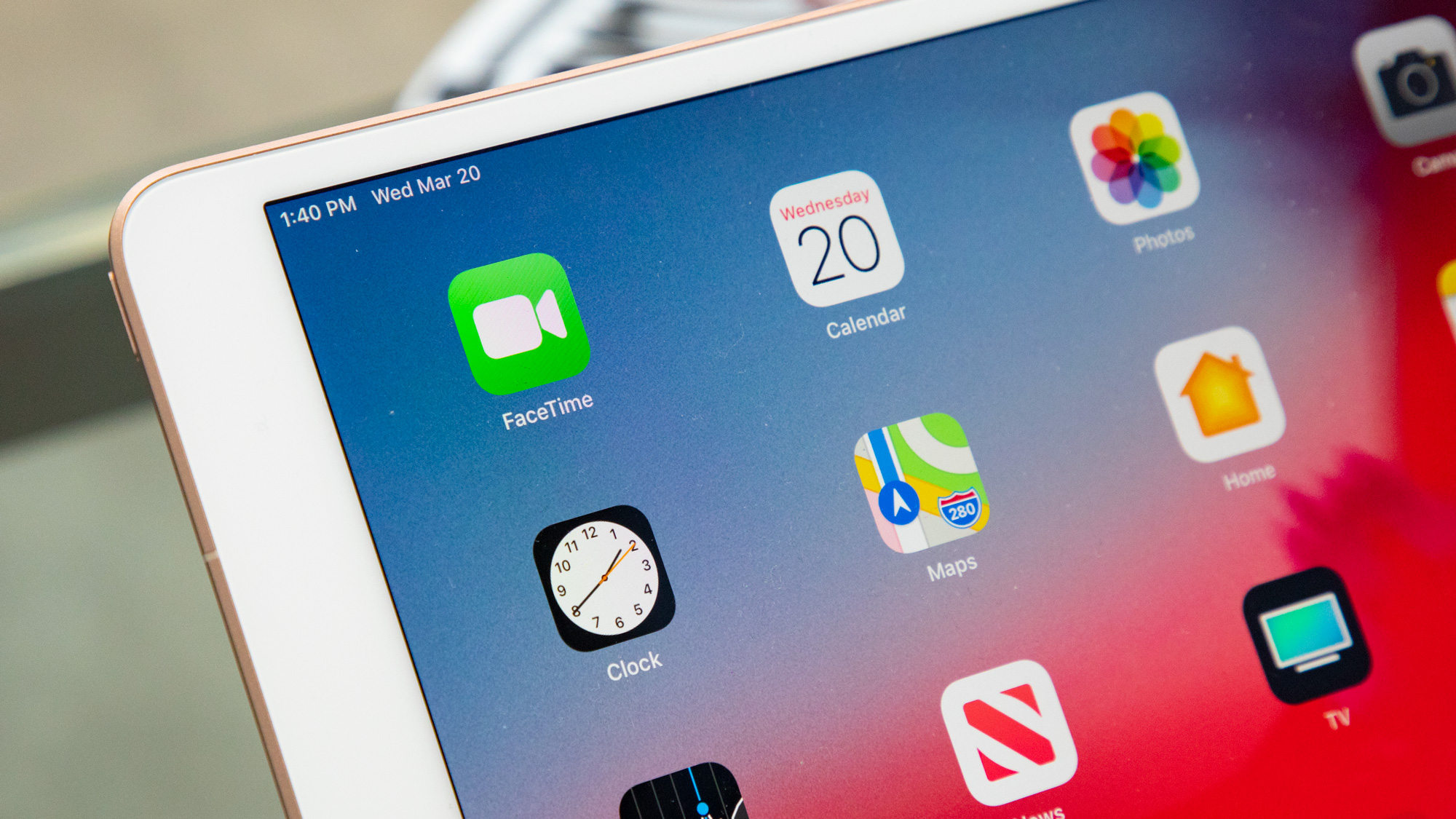
Display
- 10.5-inch display with thinner bezels is a nice upgrade over 9.7-inch iPads
- Laminated screen makes a difference when drawing with the Apple Pencil
This is the first iPad Air with a 10.5-inch Retina display and thinner bezels, and we found it to be a big upgrade over all of Apple’s 9.7-inch non-Pro tablets we’ve used in the past. This is mostly down to the fully laminated screen and wide color P3 palette.
Its laminated display means there’s almost no gap between the thinner glass on top and LCD panel underneath. The screen is pressed right up against the glass and really lets the colors pop. It’s hard to unsee the difference next to a cheaper iPad, and it’s a big deal when drawing directly on the screen with the Apple Pencil.
We noticed more yellow from this iPad Air screen, and that’s because it uses Apple’s True Tone display technology to better adapt to our environment. Without this setting enabled, the screen looked very blue compared to TechRadar’s office lighting, for example. Outside, we appreciated the screen’s anti-reflective coating that’s exclusive to this new Air and all Pro models.
The new iPad Air’s thinner bezels, laminated screen, wider color palette, True Tone display and anti-reflective coating may be enough to convince people to pick up this iPad over the iPad 9.7, which has none of these features.

Design
- Dated design, but you get relics: Touch ID and a headphone jack
- It's the thinnest non-Pro iPad sold today
- Colors: silver, gold and Space Gray
“This is the new iPad Air,” I exclaimed to my coworkers this week. Their reaction? “Really? It doesn’t look any different.” I walked away in shame (but agreeing). Don’t go into this purchase expecting big changes from this traditional-looking iPad. It won’t wow anyone like the all-screen iPad Pro 11 and iPad Pro 12.9.
But it does have fan-favorite features you won’t find on the new Pros: a 3.5mm headphone jack, and the equally-reliable Touch ID button. And the size, while subtly different from 9.7-inch iPads, allows for the fully-sized 10.5-inch Apple Smart Keyboard to be attached (the same one used by the iPad Pro 10.5).
It’s Apple’s thinnest non-Pro iPad at 6.1mm (the Pro is 5.9mm and the iPad 9.7 is 7.5mm), and also weighs just 1lb (456g). Its ‘Air’ moniker actually means something – only iPad mini (2019) is lighter at 0.66lbs (300.5g) among iPads currently on sale.
The bottom of this iPad frame sticks with the traditional lightning port (newer Pros use USB-C). That’s an okay design choice for people with tons of lightning cables already, but newer MacBook owners may be ready for the USB-C future. We feel like the bigger omission is lack of the quad speakers found on the iPad Pro 10.5 (2017). There are just two speakers here at the bottom of the tablet.
iPad Air 2019 colors consist of silver, gold and Space Gray – the latter has a black front, while the others are white. Our gold review unit looks a bit like Rose Gold or copper. Oddly enough, Rose Gold isn’t an option on this new iPad. In fact, Rose Gold isn’t an option on any iPad Apple currently sells.
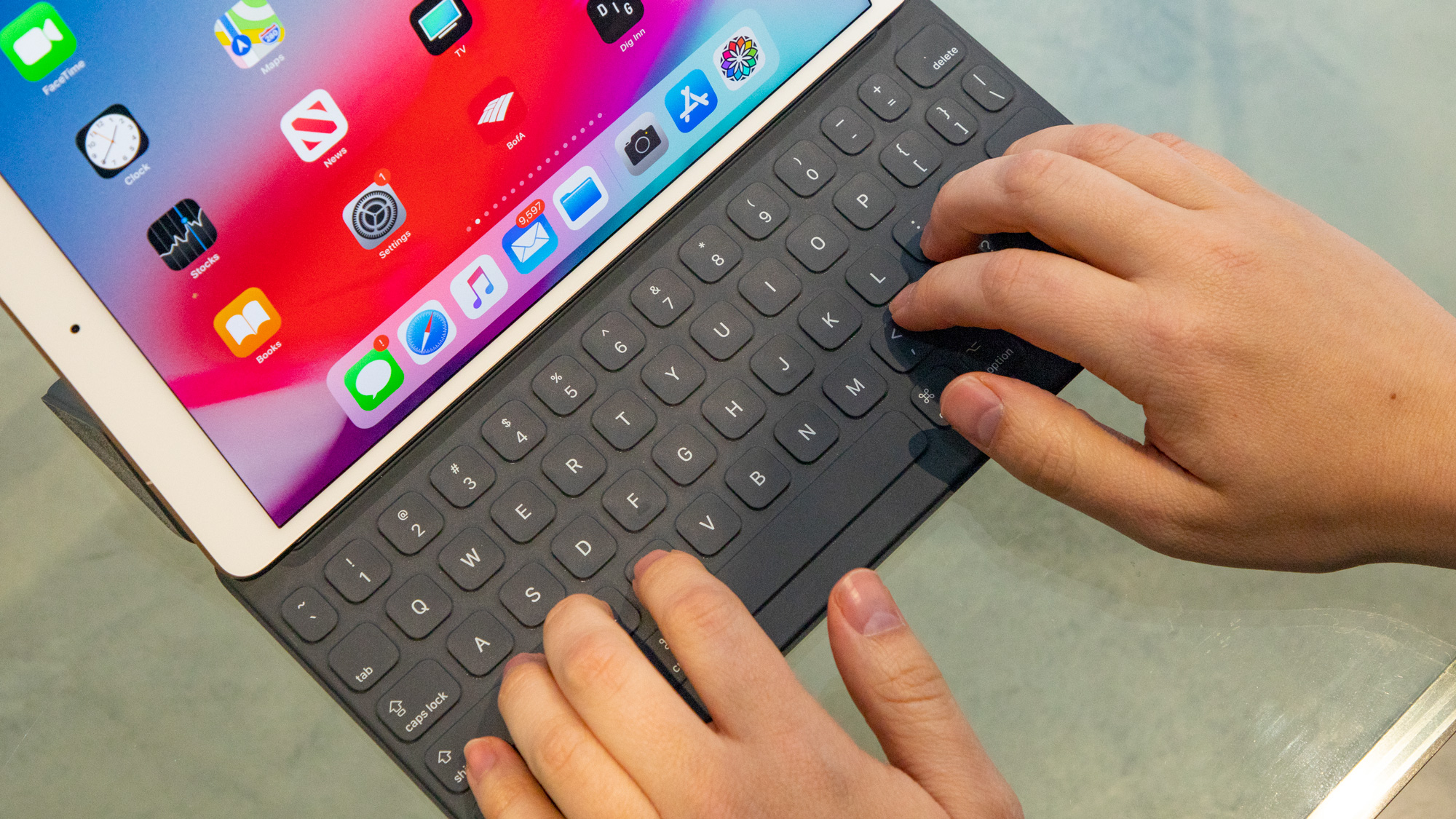
Smart Keyboard
- Smart Keyboard easily connects without Bluetooth
- One-piece fabric design is spill- and water-resistant
- No backlit keys make it hard to type in the dark
Apple’s Smart Keyboard compatibility is the reason to spring for the iPad Air over the temptingly priced iPad 9.7 that only works with Bluetooth keyboards. It’s one of the things you can’t pass up if you’re looking for 2-in-1 productivity from an iPad.
This is the cheapest iPad with Apple’s Smart Connector, which magnetically fastens the fabric tri-fold keyboard cover to the bottom (in landscape) of the tablet. No need to fumble around with those often unreliable third-party Bluetooth keyboards.
You’re forced to use low-pile keys, which isn't a problem if you’ve adjusted to recent MacBooks or Mac Magic Keyboards. What’s different is that this keyboard has a one-piece custom-woven fabric design with 64 keys etched out using lasers. Laser-etched fabric keys sound cool, and they have real-world benefits: they’re water- and stain-resistant, and impervious to debris. I carelessly ate a croissant over the iPad Air – for testing purposes – and simply wiped away the many pieces that didn’t make it into my mouth. Contrast that with various MacBooks I’ve taken to the Apple Store for repair when a single crumb gets trapped underneath the delicate butterfly keyboard.
The Smart Keyboard comes at a high price: $159 (£159, AU$235), and there are a few compromises. I can’t modify keys or keyboard shortcuts; I’d love to swap command and control, like I can do on my Mac, as I find hitting the very intendant command+C very awkward here. iOS 12 has no option for this.
I’m also hurting for a backlit Smart Keyboard – still. It’s a complaint I had in our iPad Pro 9.7 review, and back then I used my iPhone 6S Plus to shine light on the keys at night. Today, it’s an iPhone XS Max, or me yelling “Hey Siri, turn on the Philips Hue lights” at a HomePod. This iPad Air is meant to be used in all sorts of situations.
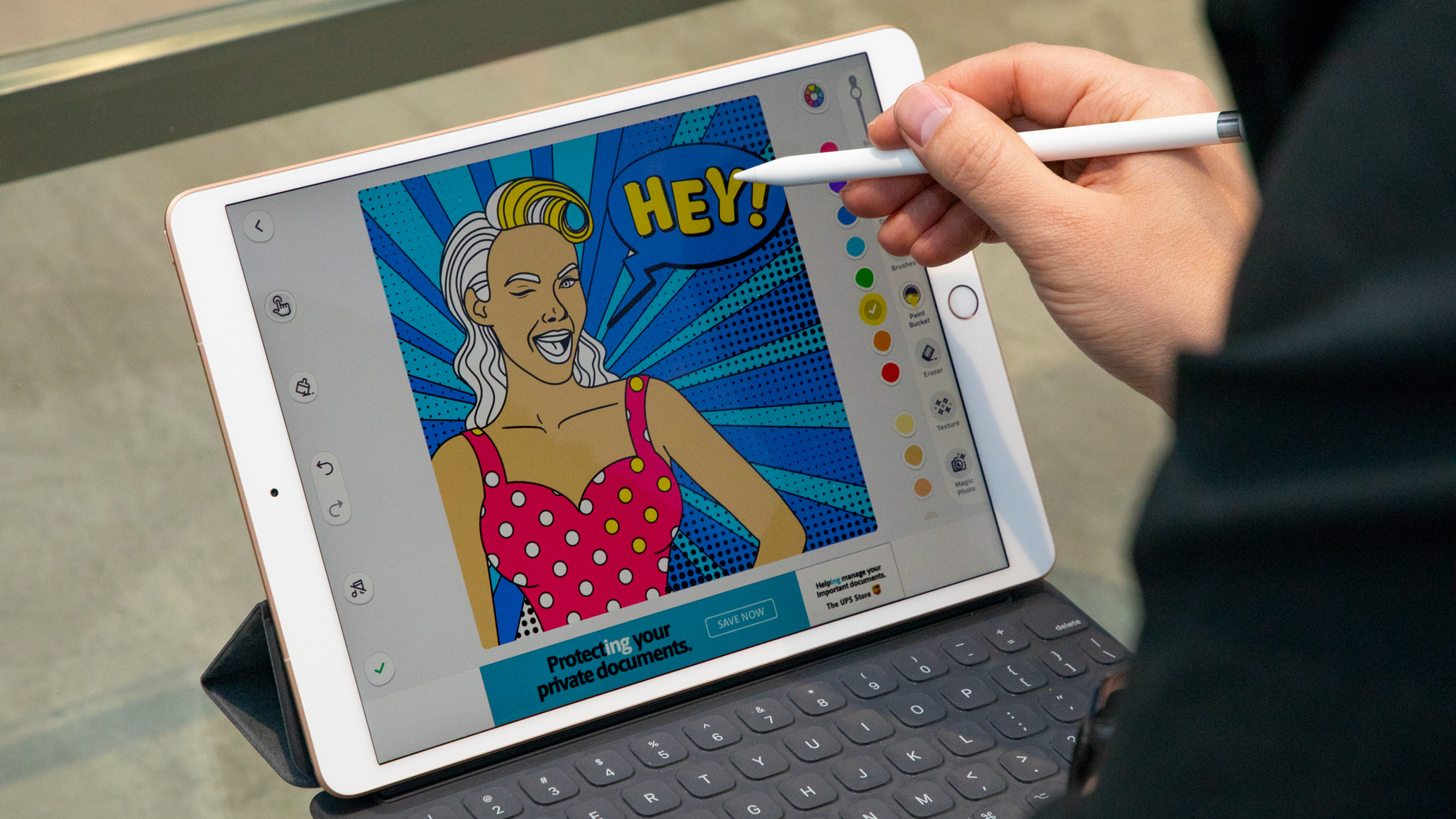
Apple Pencil
- Uses the 1st Gen Apple Pencil, instead of the Pro-exclusive 2nd Gen
- Easy to lose due to its shape, and awkward to charge in the lightning port
- Still a great pressure sensitivity for drawing and taking notes
Every iPad that Apple sells now supports an Apple Pencil, and this is the first iPad Air to be compatible with the pressure-sensitive stylus. But it only works with the first-generation Apple Pencil and Logitech Crayon.
That means it’s incompatible with Apple Pencil Gen 2, which launched alongside the iPad Pro 11 and iPad Pro 12.9. You don’t get easy magnetic charging, the flat-sided design (Gen 1 is barrel-shaped and rolls away – constantly), automatic pairing, and gesture features like tap to wake the screen and double tap to switch tools.
Charging the Apple Pencil Gen 1 remains precarious, with its capped end containing a Lightning connector that plugs into the iPad Air. It can break off easily and the entire thing is heavier than the Gen 2 version. It’s the single biggest letdown of the iPad Air, mostly because our Apple Pencil rolled off the table twice while writing this.
The good news is that the original Apple Pencil is cheaper and contains the same responsiveness as Gen 2 against an iPad screen. Drawing on the iPad Air, we experienced no lag, could create thicker lines by applying more pressure, and tilted the Pencil for shading. It’s also our favorite way to annotate screenshots.
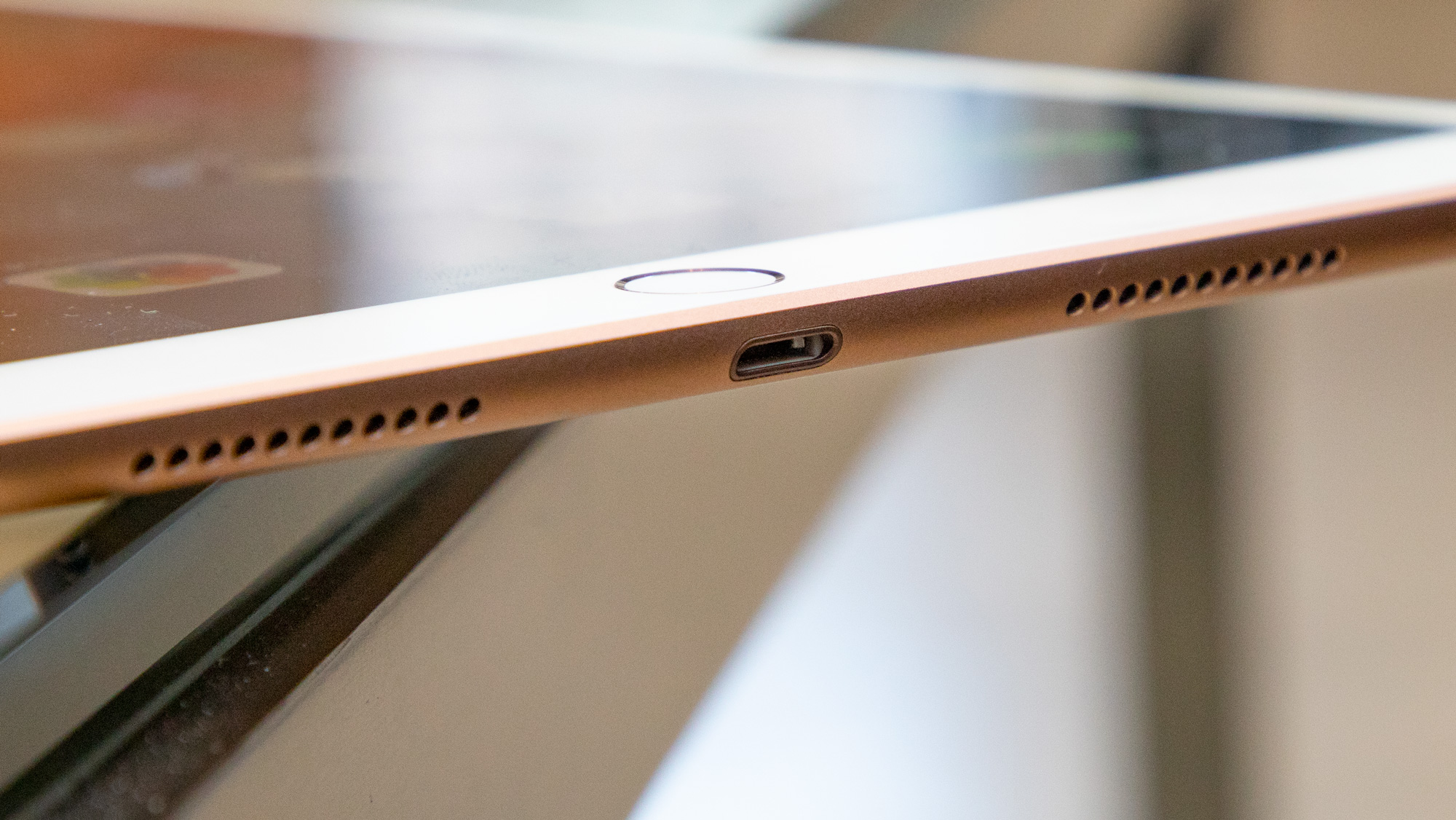
Performance
- Powerful A12 chipset found in iPhone XS and XS Max
- Doubles the performance of the cheaper iPad 9.7 (2018)
- 64GB and 256GB internal storage configurations
The real reason to buy this iPad Air is the grunt hidden behind its colorful laminated display. It’s one of Apple’s most powerful iPads, rivaling the performance many today’s best laptops.
It doubles the performance of the entry-level iPad 9.7 (2018), according to our tests, offering another perk for anyone seeking serious productivity and looking for a long-term investment. It’s equipped with Apple’s custom A12 Bionic chipset, the same powerful System-on-a-Chip inside the iPhone XS and iPhone XS Max.
The chip scored an 11,575 in the all-important a multi-core benchmark test. Among tablets, it’s only bested by the iPad Pro 11 and iPad Pro 12.9, which has the A12X Bionic chipset and a 17,845 score. The iPad 9.7, with its iPhone 7-era A10 Fusion chip, gave us a 5,786 score. It's also better than two-year-old iPad Pro 10.5 (9,326).
The performance bump translates into two important things: better speed for current apps and multitasking, and future-proofing the performance of the iPad Air. The base iPad Air configuration is 64GB, which is okay, and the top-line version is a much more acceptable 256GB version for extra cash. Sadly, there’s no 128GB option to meet everyone's needs in the middle.
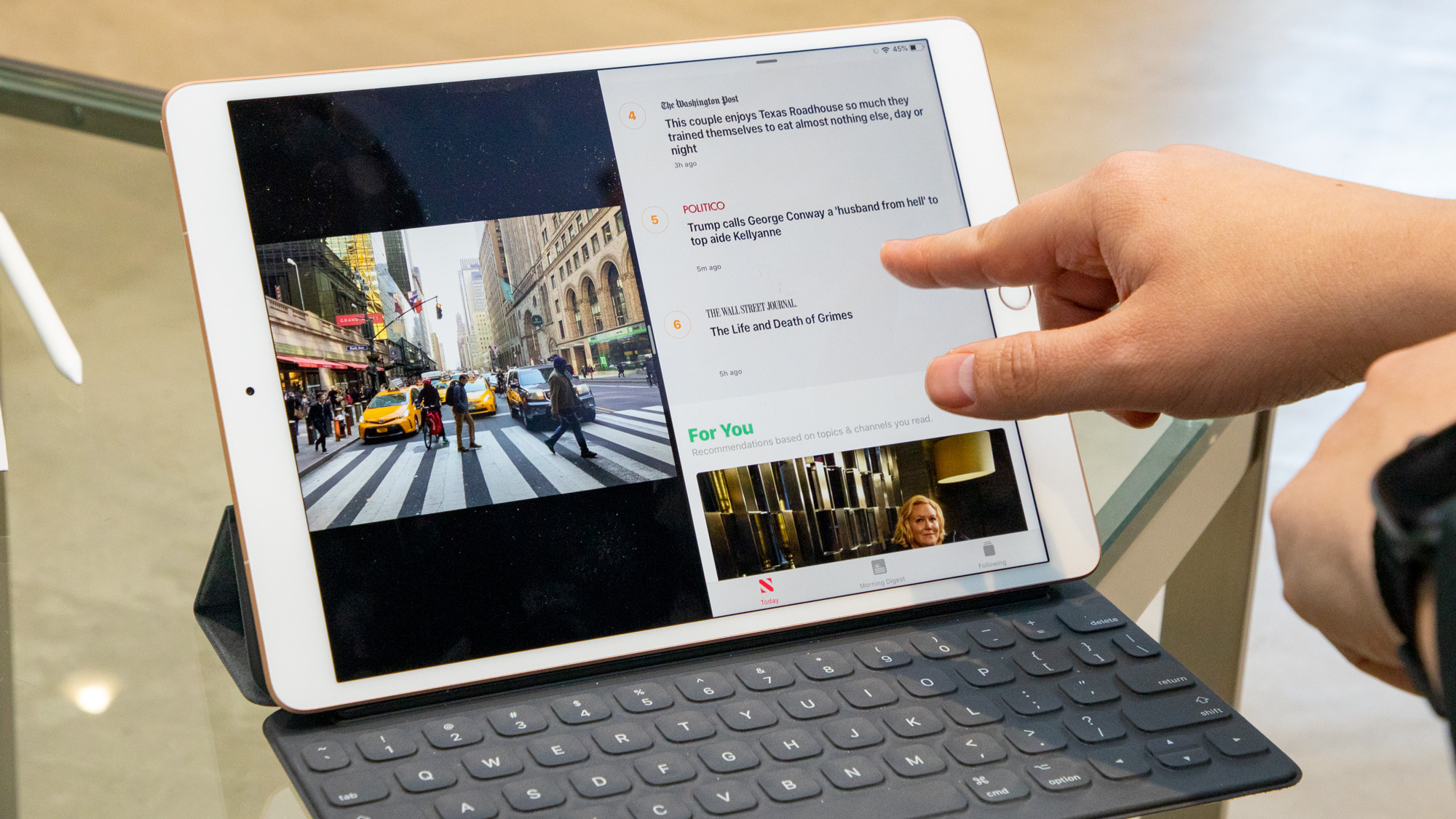
Software
- New markup tools and Screen Time monitoring
- Multitasking is here, but it’s iPad’s biggest limitation
- No mouse support or true dock for easier app switching
The iPad Air runs iOS 12, and it does make navigating Apple’s ‘computer’ easier than iOS 11 and certainly iOS 10, but we’re still here waiting for iOS 13 to really change things up.
App switching by pulling up the out-of-sight bottom dock does take a few gestures, but once you get the hang of it, it’s rather easy to pop two supported apps into Split View and drag text across. You’re just not going to find a permanent dock at the bottom or mouse support here.
Apple’s Smart Keyboard makes the iPad Air our favorite way to accomplish single tasks, like writing reviews. It’s also a great way to control lights and other HomeKit-compatible gadgets in our budding smart home via the Apple Home app. But for more complex research involving tabs (“What were the specs of the older iPad?”), we found ourselves seeking a Mac.
We really got use out of the Apple Pencil with the software’s new markup options, allowing you to take a screenshot and instantly start annotating on the captured moment. Changing up the pen thickness and color is easier than ever, too.
iOS 12 also has other minor tablet perks worth mentioning: the redesigned Apple News app, deeper battery life stats, Screen Time (iPad usage numbers ideal for parents who let their kids borrow the iPad), and compatibility with third-party password managers.
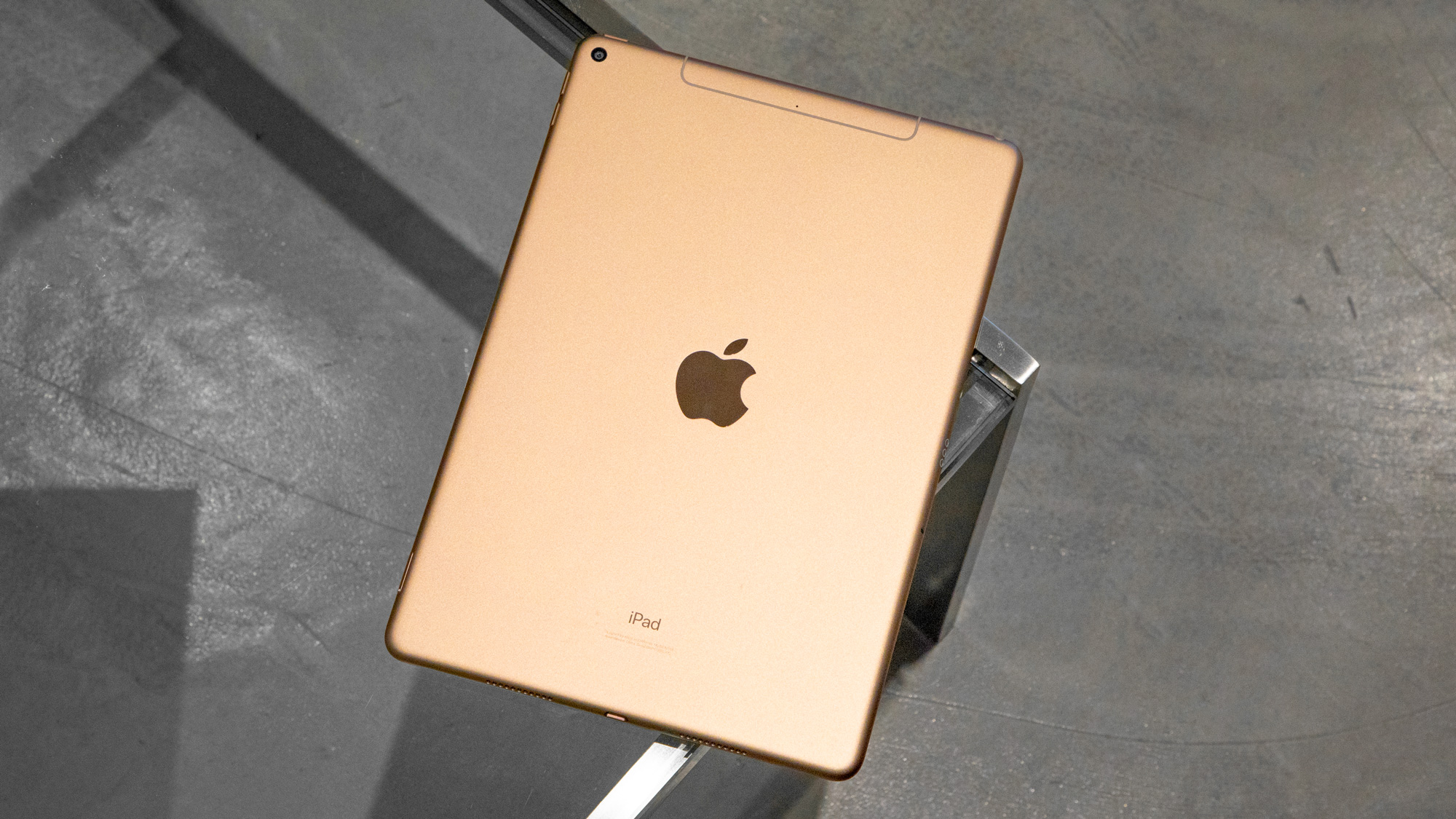
Battery life
- 10 hours of battery life – but lasts a day with on and off usage
- Fast charges with the Lightning-to-USB-C cable and plug
Apple has a very diverse lineup of iPads now, but here’s something interesting: they all have the same battery life – 10 hours of surfing the web on Wi-Fi, watching videos or listening to music.
That reflects what we saw when using the new iPad Air, however, it greatly depends on how you use the iPad. Standby time can be incredible, so on and off usage throughout the day gave us more than 24 hours with the iPad. With infrequent use, it can likely last a week on standby.
No surprise, as we cranked out more tasks, played AR games, and treated this iPad more like a laptop, we noticed a dip. Mail and photo editing were where we saw the biggest drains among any single apps, according to the deeper battery life menu. Likewise, since we had the WiFi + Cellular version of the iPad, we noticed a another dip solely relying on our SIM card. Low-power mode really helps save battery life.
The best news is that this is the first iPad Air with fast charging. That’s been exclusive to newer Pro models before today (every Pro except the iPad Pro 9.7), so you won’t find it on the cheaper iPad 9.7. The iPad Air 2019 was able to charge to 17% in just 15 minutes and 32% in 30 minutes when we used a Lighting-to-USB-C cable and our 13-inch MacBook Pro USB-C plug (it happened to be nearby). It took a total of 2 hours and 28 minutes to fully charge the iPad, which isn’t so bad.
Re-charge rate (via Fast Charging) from 0%
- 15 mins: 17%
- 30 mins: 32%
- 45 mins: 47%
- 60 mins: 63%
- 75 mins: 79%
- 90 mins: 86%
- 105 mins: 92%
- 120 mins: 96%
- 135 mins: 98%
- 100% at 2h 28m
It also didn’t take long for the iPad Air to turn back on whenever we used this cable. While sold separately, the USB-C-to-Lightning cable and a USB-C plug are worth the cost if you intend to use your iPad Air frequently.
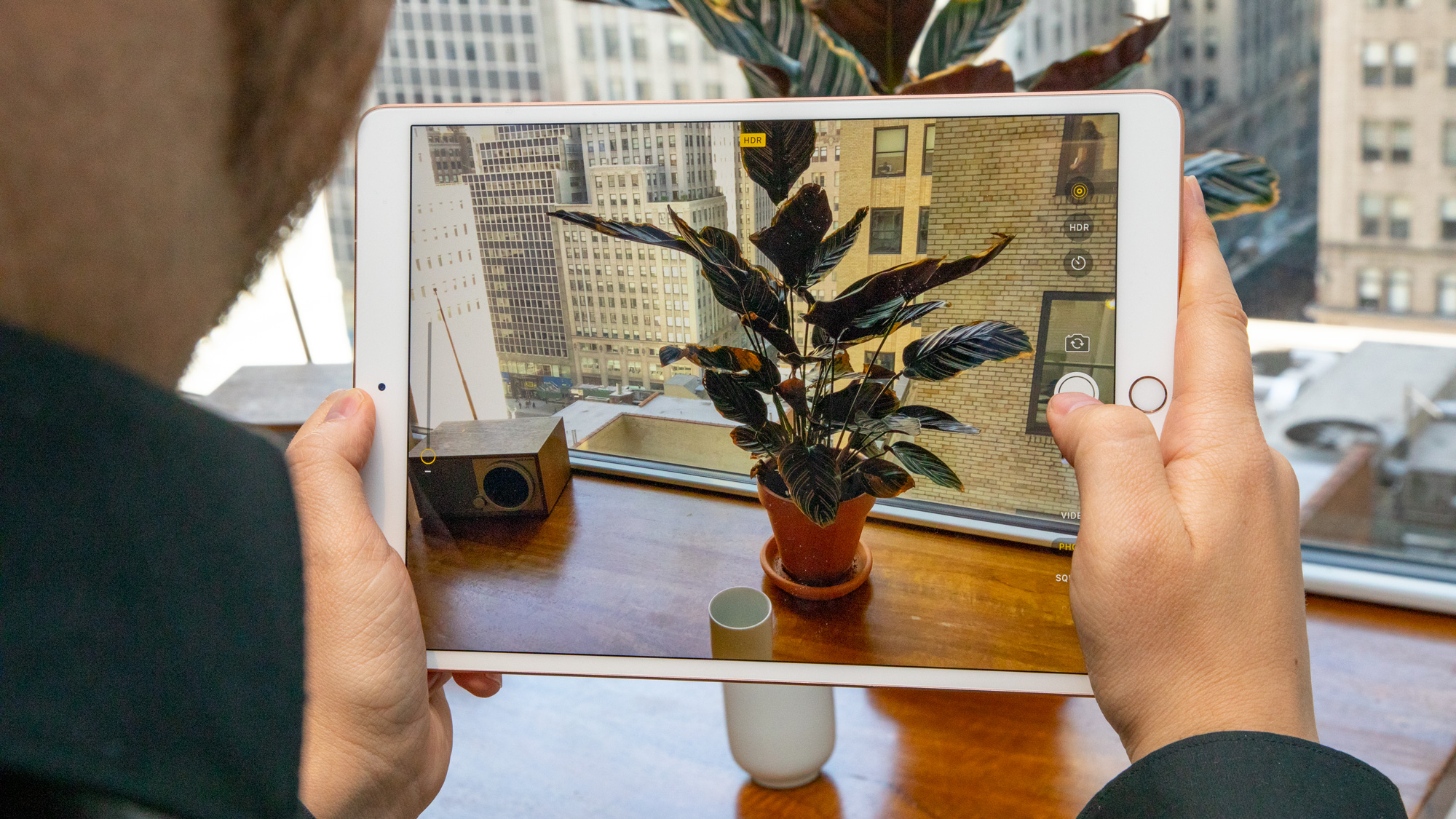
Camera
- Takes perfectly good 12MP photos – for a tablet
- Same rear camera as iPad 9.7, but better front camera
- Won’t compare to your newer iPhone
The iPad Air takes respectable photos for a tablet, but it will never compare to your smartphone, and you also look rather foolish holding up a 10.5-inch display just to capture a shot.
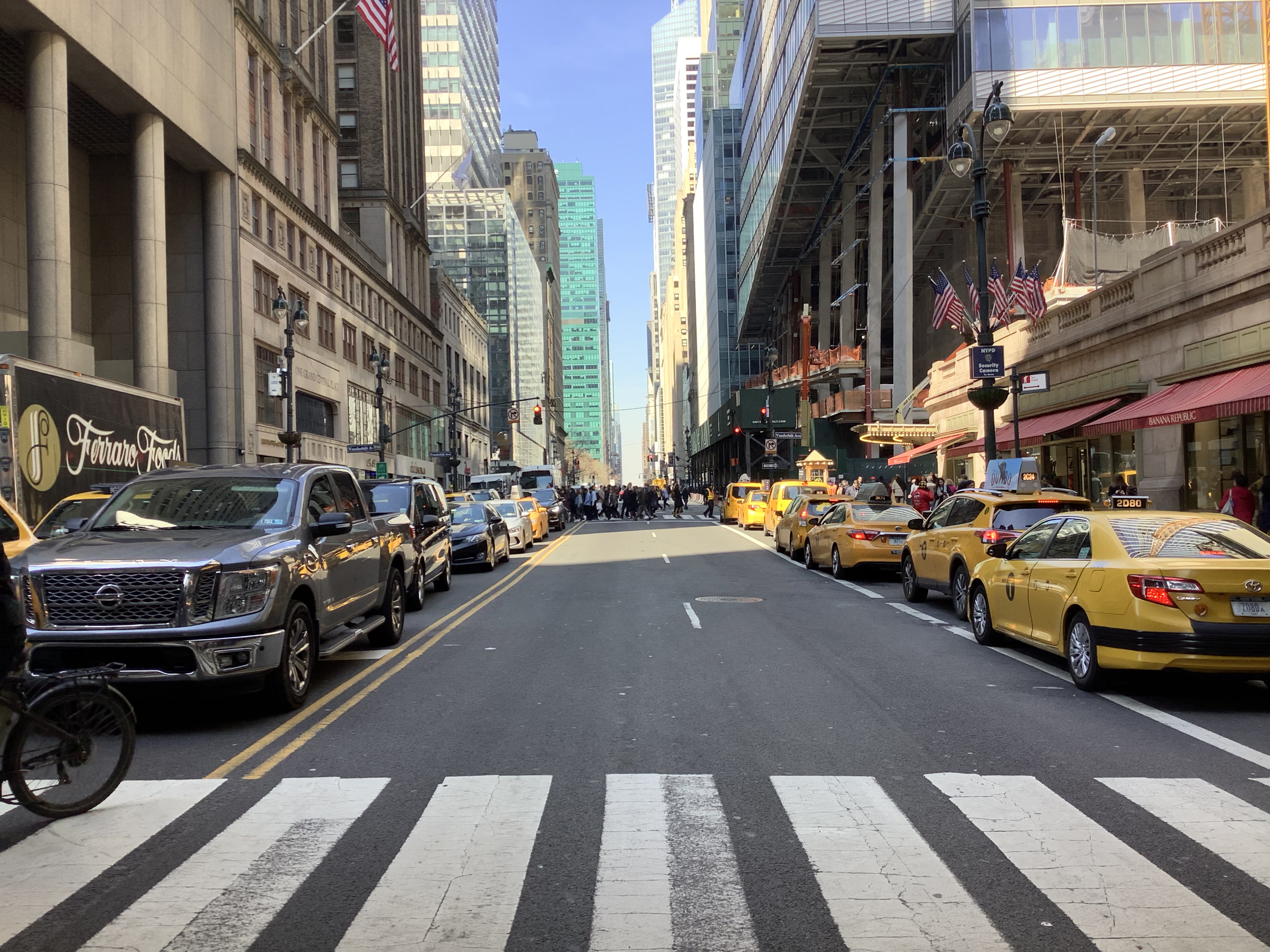









We get it, some people just need a really good reference shot for a school or work project, and old people love to use the big ol’ viewfinder of an iPad. It has its niche place. For those few acceptable reasons, the iPad Air’s rear camera captures 8MP photos with an f/2.4 aperture, the same as the entry-level iPad 9.7.
Who's it for?
Good performance at a respectable price
It doubles the performance of the iPad 9.7 and keeps up with some of the best laptops. It doesn't quite get to new iPad Pro levels, but the speed and price make it a good value.
Students who want a 2-in-1 tablet
This tablet works with the easy-to-pair Apple Smart Keyboard cover, and that makes it ideal for taking notes, sending email and working on simple tasks during class.
You want the cheapest iPad for productivity
The iPad Pros are too expensive for most people, but the iPad 9.7 is a read-not-write sort of tablet. This iPad gives you productivity without breaking the bank.
- Find the best deals on Apple products with our Apple discount codes.
Who's it not for?
You're looking for the cheapest iPad
It's the cheapest iPad for productivity, but not the cheapest iPad. Casual users are better served by the iPad 9.7, which is cheaper without deals (and there are often deals).
You want great Apple Pencil support
Its Apple Pencil Gen 1 support is the biggest letdown when there's Gen 2 out there with gestures and magnetic charges. The original Apple Pencil's worst flaw is rolling off the table.
You need laptop-level productivity
It has the speed, but the software doesn't lend itself to speedy multi-tasking, the keyboard doesn't light up, and there's no mouse support. iOS 12 has a productivity cap.
Competition
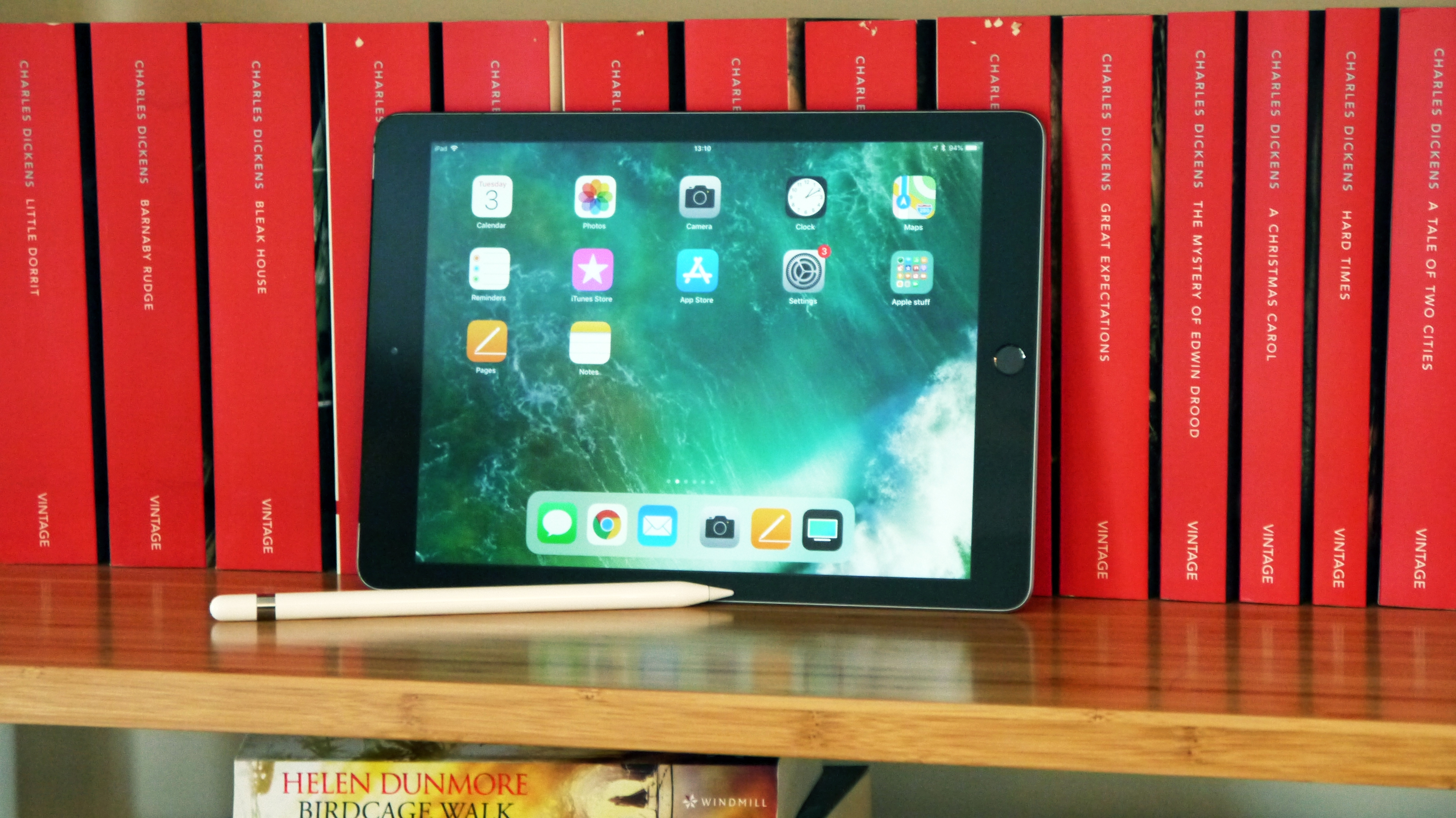
iPad 9.7 (2018)
Both last year’s iPad 9.7 and the new iPad Air are competing for much of the same audience: people who want a new iPad, but can’t afford the redesigned iPad Pro. The iPad 9.7 is such a great value for most of the features you’ll ever need on a tablet. It’s a great way to read books and news, and watch movies. It doesn’t feel particularly productivity-focused, and the screen isn’t as quite good next to the iPad Air.

iPad Pro 11
The iPad Pro 11 is the next step up from the new Air, giving you a lot less bezel (Apple calls this its Liquid Retina Display), even more performance, and a True Depth camera for Face ID and Animoji. What we really like here is that it uses the second-generation Apple Pencil. It easily charges and clips to the frame of the iPad Pro with a strong magnet and uses some nifty gesture controls when you tap the screen. Just know there’s a big price jump between the iPad Pro 11 and the middle-of-the-road 10.5-inch Air.

Samsung Galaxy Tab S4
Maybe you think you don’t need an iPad and you’ll be tempted by the Samsung Galaxy Tab S4. Think again. While this is a good Android tablet, iOS has always been superior in the tablet space (too many Android apps fail to properly blow up on the big screen), and this tablet is a bit overpriced next to the new iPad Air. Samsung does make a gorgeous screen and include a desktop mode we really liked on paper, but that hasn’t been well executed yet. It’s an alright tablet, but we actually find the Galaxy Tab S3 to be a better value with only a few sacrifices.
